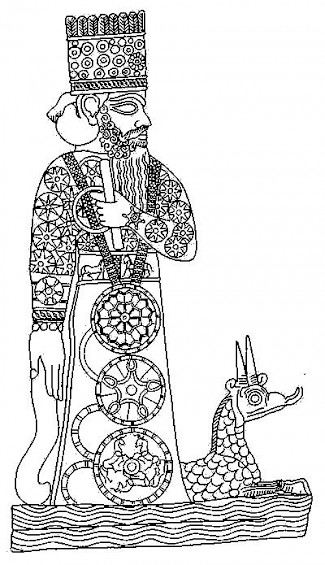Akitu Festival
Akitu: the Babylonian New year's festival, celebrated to honor the supreme god Marduk, his crown prince Nabû and other gods.

The name Akitu is very ancient. In the third millennium BCE, the Sumerian population of southern Mesopotamia celebrated the á-ki-ti-še-gur10-ku5, the festival of the sowing of barley. It was celebrated in the first month of the year, that is in March/April. In the Babylonian calendar, this month was known as Nisannu (and in the modern Jewish calendar is still called Nisan). Since the festival was celebrated on the first days of the Babylonian year, we can call it a New year's festival. In fact, the ancient Babylonians already called it rêš šattim, "beginning of the year".
The festival - better: conglomerate of festivities - was celebrated on two locations in Babylon: in the temple of the supreme god Marduk, the Esagila, and the 'house of the New year' which was situated north of the city. The two gods who were in the center of the festival were Nabû and his father, the supreme god Marduk, who was in the first millennium BCE usually called 'Bêl', Lord, because his real name was considered too holy to be pronounced.
On 4 Nisannu, the high priest of the Esagila (šešgallu) opened the festival, saying that the new year had begun. To the populace, this meant the beginning of a holiday of a week. On the same day, the king went to the temple of Nabû, where the high priest gave him the royal scepter. He then traveled to Borsippa, a city 17 kilometers downstream from Babylon that had a famous Nabû temple. Here, he spent the night. At the same time, the šešgallu recited the Babylonian creation epic (Enûma eliš) in the house of the New year.
The fifth of Nisannu saw the king's return to Babylon, accompanied by the statue of Nabû from Borsippa. The statue was left behind in the Uraš gate, and the king went to the Esagila to greet Marduk. He had to do this humbly, laying down his weapons, crown and scepter. The šešgallu listened to the king's words that he had not sinned against Marduk and hit him very hard on the cheek (the king had to have tears in his eyes). Perhaps, this was a punishment for sins that were unwillingly committed. Kneeling in front of the statue of Marduk, the king receives an oracle about the glorious future, and was given back his royal insignia. At sunset, the king and the šešgallu performed a not completely understood ritual with a white bull.
Next day, the statue of Nabû visited the temple of Ninurta, where it defeated two enemies (in the form of golden statuettes). Then, it continued to the Esagila, where it joined Marduk's statue. At the same time, other statues of other gods arrived at Babylon.
On 7 Nisannu, the statues were cleaned and received new dresses. On the next day, the festival reached its climax when all statues were brought out from their rooms and shown to the Babylonian populace. All gods were now present to honor Marduk, and their 'parliament' announced its policy for the next year. (One is reminded of the 'state of the union' speech by the American president.) As far as we know, this policy was always one of blessing, fortune and success. After these joyful tidings, the gods started a tour through the city to the river. Here, they boarded a small fleet, that brought them to the house of the New year. The king himself guided the supreme god. On the last part of the route, the ships were placed on chariots, so that the gods were driven to the house of the New year in ships.
The people were singing all kinds of songs. Three of them can be reconstructed: a frivolous hymn to the goddess of sexuality and love Ištar, a song in which Marduk's father Enlil was ridiculed as a god in the gutter, and an antiphonal hymn in which the gods were asked why they were not in their temples and replied that they had to be with Marduk.
What happened in the house of the New year on 9-10 Nisannu, is not known, but it seems that sacrifices were made by the king and that the spoils of war were presented to the gods. On 11 Nisannu, the gods returned to the Esagila, where they repeated their parliament. After this, they saw Nabû off, and went home.
The Akitu festival continued for centuries, and not only in Babylon. In Palmyra, the temple of Baal was inaugurated on the same date as Akitu. At the beginning of the third century CE, it was still celebated in Emessa in Syria, to honor the god Elagabal; the Roman emperor Heliogabalus (218-222) even introduced the festival in Ital.note
Literature
K. van der Toorn, "Het Babylonische Nieuwjaarsfeest" in Phoenix. Bulletin van het Vooraziatisch-Egyptisch genootschap Ex Oriente Lux 36/1 (1990) 10-29